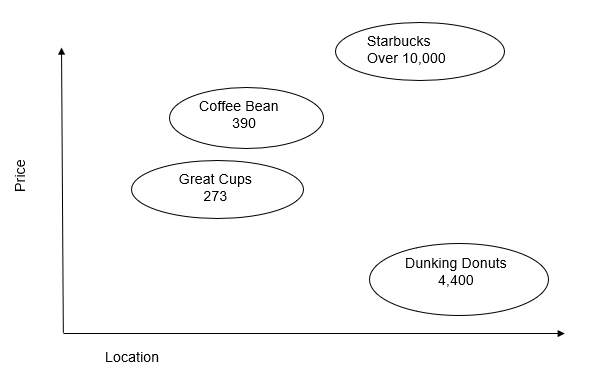Industry Description
At early stages of development, the company at issue began operating as Great Cups of Columbus in Ohio area. The main concept of the company lied in delivering coffee in over-sized cups to adhere to their motto: “A Great Coffee of Coffee, at a Great Price”. Further development of company’s strategies focused on the analysis of its major competitors, such as Starbucks.
To stand the competition, the managers started developing and, as a result, the company managed to expand its market share within a decade. With regard to economic variables, it should be stressed that the company is affected by such forces as economic rates, energy price, GDP tendencies, and acceptability. In this respect, higher employment rates might lead to changes to coffee consumption and to increase in food products sales at the account of retail coffee delivery.
According to the information received from the U.S. Census Bureau (2006), there is a 7.6 % annual increase in sales of the company’s products. The company’s revenues, therefore, increased from $ 7 billion in 2000 up to $ 11 billion in 5 years (Specialty Coffee Association of America, 2005).
Regarding the societal and demographic factors, it should be stressed that coffee is considered one of the most consumed products in the United States and abroad. Therefore, greater demand for coffee can be ensured through increasing the quality of product and services for consumers.
Currently, the company continues its expansion policy by developing new coffee stores in different regions and considering new cultural and social layers of the US population (Great Cups Coffee Company, 2011). As a result of the proposed strategy, consumer’s analysis has triggered the coffee producers to focus on sustainable coffees that are more concerned with environmental factors.
As compared to alcohol and tobacco products, the coffee has strengthened its position at the market due to the enhanced brand loyalty and development of a new concept of the product as a noble beverage. Within the industry matrix, the major criteria for company’s success involve such aspects as convenience of location, product quality, service speed, product range, and pricing strategy.
Porter’s Five Forces Analysis
The consideration of the factors determining the successful development and profitability of industry is important because it allows the managers to predict future potential and shortcomings of industry expansion (Ahlstrom & Bruton, 2009).
With regard to these issues, the Great Cups Coffee Company should be more focused on such forces as location and price that are interconnected in the fight for a competitive advantage. The proposed Strategic Group Map developed below considers the above-mentioned aspects.

The graphic diagram demonstrates the competitiveness of the leading coffee industries with regard to price and location. From the above-established indices, it is seen that Great Cups is the most successful in terms of its pricing and location policy whereas Starbucks is more focused on price rather than on location and, therefore, its competitiveness is much higher than the Great Cups.
Second, lower price of the Great Cups’ products does not ensure its advantage over other producers due to the lack of the brand image, as compared to Starbucks and Dunkin Donuts. Therefore, this gap should be fulfilled to continue their market expansion.
Despite the disadvantages, the Great Cups Coffee has a beneficial position in terms of reasonable price, high quality products, and market segmentation. In order to prevent the risks, specific emphasis should be placed on societal environment analysis to present coffee as a brand, but not as a commodity to be consumed.
A Summary of Opportunities and Threats to Retail Coffee Chains Participating in the Coffee Industry
Due to the great competition and a range of directions for development, the Great Cups Coffee Company has great opportunities for market expansion due to the rapid growth in the coffee industry. The emergence of new distribution channels, as well as product expansion, can provide a new option for developing the image of the product and create the shift from consumerist ideology (Hunger & Wheelen, 2003).
In addition, expansion of stores and exploration of new geographic locations is also crucial because it allows managers to predict the needs of new clients’ base. Finally, developing a limited product portfolio and presenting store names should also widen the company’s opportunities and provide a competitive advantage.
As per the threats, the company should constantly invent new strategies to face rigid competition because coffee is considered among the most consumed products all over the world. Further, pricing strategy and demand rates must be considered as a solution to the brisk competition. The Great Cups Coffee’s major competitor is Starbucks that successfully uses its pricing and location philosophy to be the leading coffee provider (Gillespie, 2005).
Finally, the company should also pay attention to the cultural environment and moral codes within an organization to strengthen the values among the employees. Both consumers and employees should be aware of the strong mission of an organization that relies on improvement of the overall climate and quality of services.
References
Ahlstrom, D., & Bruton, G. D. (2009). International Management: Strategy and Culture in the Emerging World. US: Cengage Learning.
Gillespie, E. M. (2005). Starbucks sees growing demand for drive-thru coffee. The Associated Press. Web.
Great Cups Coffee Company (2011). About Great Cups. Web.
Hunger, J. D. & Wheelen, T. L. (2003). Essentials of strategic management (3rd ed.). Upper Saddle River, NJ: Prentice Hall.
Specialty Coffee Association of America (2005). Specialty Coffee Retail in the USA 2005. Web.
U.S. Census Bureau (2006). Advance monthly sales for retail and food services: July 2006 release. Web.